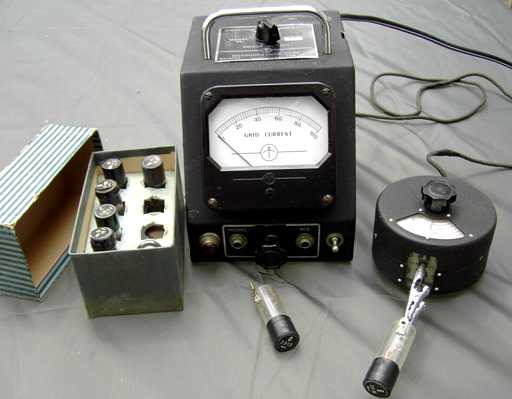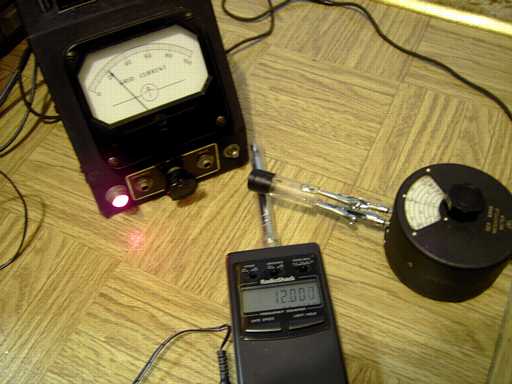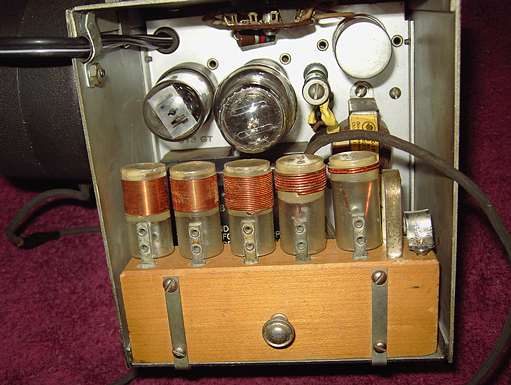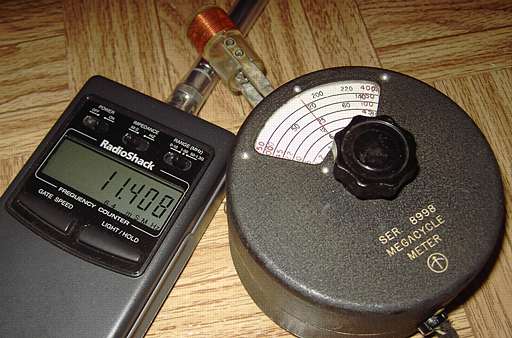Measurements Model 59 with Eico coils.


Sniffing the frequency directly with a counter.
The Measurements Corporation Model 59 "Megacycle Meter" is arguably one of the best grid dip meters ever made. Its large meter, separate head, quality of components, and regulated power supply are part of why this is a preferred grid dip meter. When I bought it, this example was very dirty and the case was dented. It did not function at all. The coil set was missing. But the price was right. I thought I could possibly wind a coil or two for it.
Measurements Model 59 with Eico coils.


Sniffing the frequency directly with a counter.
Repairs
I cleaned the 59, straightened the bent housing, and replaced the power cord. The dropping resistor to the voltage regulator tube was open. Replacing that resistor, reforming the electrolytic, and cleaning the power switch contacts was all that was needed for repair.
Now what to do about the missing coil set? The inductance and distributed capacitance of the coil sets have to match the grid dip meter so that the grid dip meter's dial scale has some accuracy.
However, it dawned on me that I did not need the dial scale to determine the frequency of a dip. I had what the Measurements engineers could only dream about when they built the 59, a direct-reading frequency counter. The frequency as measured on a counter is much more accurate than any grid dip dial scale could be. Just a single loop or two to sniff out the frequency of the grid dip meter is all that is needed.
Replacement coils and using a counter for accuracy
I had a set of grid dip meter coils for the Eico 710 . I attached a couple of alligator clips onto banana plugs to clip the Eico coils to the Measurements 59. The picture shows a little Radio Shack counter measuring the meter's oscillator at 12.000 MHz. I normally use a Heathkit counter with a loop so that the counter does not have to be so close to the coil. This is to minimize any possible effect on the oscillator frequency.
With the Eico coils and the counter, I can ignore the dial scale. I also use the Eico coils that cover lower frequencies than the 2.2 Megahertz that is the lower limit for which the 59 was originally designed.
Using a dip meter
A Grid Dip meter is also called a grid dip oscillator or GDO for short. The oscillator's grid current is measured in normal operation. When the coil of the dip meter is moved close to an external tuned circuit and the dip meter is tuned to a setting that is resonant for that external tuned circuit, a bit of power is drawn by the tuned circuit. This reduces the grid current and is seen as a "dip" in the meter. That external "tuned circuit" can be an antenna or a transmitter's tank circuit (with the transmitter's power turned OFF) , or any of a number of tuned circuits encountered in receivers and transmitters.
A dip meter can also be used with a standard to determine inductance or capacitance. Other uses are detailed in the manuals. The manual for the Measurements 59 can be found at this link under the Boonton name as the Boonton model 59 (Boonton, N.J. was the home of the Measurements Corporation.) It has some very good information on uses of a Grid Dip meter.
Comparing some of the lesser-quality dip meters
While the Measurements 59 and the Millen (with which I have no experience) are generally considered to be the best GDO's, I personally consider the PACO G-15 and the Knight (Allied Radio) G-30 to be some of the better of the lower end ham dip meters because of the detail in the manuals and coverage of the lower frequencies. I have the Heathkit GD-1 also but prefer the physical construction of the PACO and Knight. However, except for the lower frequency limitation which I have overcome by using the Eico coils, the Measurements 59 is the first choice by far.
Latest update on the Measurements 59 - Original coils once again
After using the 59 with non-original coils for a couple of months, I received a set of original coils thanks to the generosity of Herb W5AN. Many thanks Herb! My 59 appreciates being a complete system once again.
Although the serial numbers obviously do not match my 59, two of the coils are fairly close while, with the others, the scale reads about 10 to 15% high. The scale is definitely usable especially in conjunction with the counter. I thought about making a correction chart but with the counter close at hand, there is no need, especially since I know roughly the amount of correction required. Note that the scale was totally meaningless when using the Eico coils. The highest frequency ranges for the 59 definitely need the proper coils and those ranges are where the 59 really shows its excellence.
The Measurements 59 with an original coil set.
The 59 set at 12 MHz shows a close 11.4 MHz with this coil.
A Motorola Chairside from WW II was the previous item on the bench.